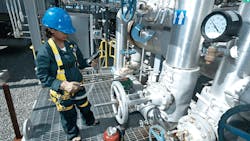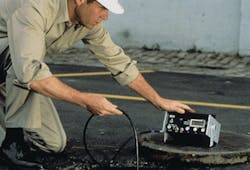Many articles have been written about confined spaces, including a couple that I have authored. But there only are so many ways that you can describe a confined space, including the permit-required ones.
I am going to put a different twist on the topic of confined spaces and share some of the things I have learned over the years while working in, around and teaching confined space safety as a training specialist. I will provide answers to some recent questions that I have been asked about confined spaces and the gas detection equipment that should be used prior to entering them.
Question #1:
Are there any general rules to follow when approaching a confined space?
The answer is yes. If you are unfamiliar with a confined space, the first thing you should consider is what has been stored in the space. This will help you determine some of the hazards and the precautions that should be taken in order to safety enter the space.
See Also: Workplace Environment Protection & Policy Information
If the confined space has been used to store toluene, for example, there are several hazards that need to be addressed. Toluene is a flammable product with an explosive range of 1.1 percent to 7.1 percent by volume. Any product remaining in the space must be properly removed to minimize any potential for explosion. Another fact about toluene is that its molecular weight is 92.1 mw, which makes it approximately three times heavier than air. The toluene vapors will "pour" out of a confined space like unseen water. This is important because any ignition sources in the area can start a fire and lead to an explosion if the fire traces back to the confined space.
Then there is the toxicity. Toluene has another hazard that many do not recognize and fail to observe. The exposure limit for toluene, based on the NIOSH Pocket Guide (REL), is TWA 100 ppm. The concern here is the detection method for toluene.
In most cases, flammable and combustible materials are detected using an instrument that has a catalytic bead sensor installed in it. This type of sensor is great for detecting the flammable range of a substance in the LEL or lower explosive range. The 1.1 percent by volume of the toluene that is listed above is the LEL. Alarms for combustibles are set to 10 percent of the LEL, based on the permit-required confined space regulations published by OSHA. Any reading below that is an assumption that you are safe. This is true as far as flammability, but the toxicity still exists.
With the exposure limit of toluene at 100 ppm, and the flammability measured in LEL, we need to know the conversion rate. Starting with a space being 100 percent full, that area also can be described a 1 million ppm. That is from where the ppm definition comes. It can be expressed by the following example.
| 1 million ppm = | 100% by volume |
| 100 | 100 |
When completing the math, you get 10,000 ppm = 1 percent by volume.
Going back to the information on the flammability of toluene, 1.1 percent by volume is 100 percent LEL. Knowing our conversion, that makes the LEL of toluene 11,000 ppm. Now, taking the alarm of 10 percent LEL that is 1,100 ppm and 1 percent LEL is 110 ppm. With the exposure limit of toluene being 100 ppm, using an instrument with a catalytic combustible sensor will not give the level of protection needed for the entrants of a storage tank of toluene.
This is where the extra knowledge provided by a photo ionization detector (PID) is important. A PID sensor is designed to detect several gas vapors, typically volatile organic compounds (VOCs) like toluene. An instrument with a PID sensor in addition to a catalytic sensor not only will ensure that the area is safe of explosive hazards, but it also will detect those substances in the PPM range to warn of any toxic levels.
As you can see, without the right information about the space you are about to enter, there could be serious consequences.
Question #2:
How long has the confined space been undisturbed?
This is important to consider if you are unfamiliar with a specific confined space and are determining if any stratification has occurred. Common knowledge is that gases have different molecular weights. For example, the molecular weight of hydrogen sulfide is 34, methane is 16 and carbon monoxide is 28. Based on air being 21 percent oxygen (O2) with a molecular weight of 32, and 79 percent nitrogen (N2) with a molecular weight of 28 – along with some trace gases – the molecular weight of air is approximately 30.
No. 1, having a molecular weight of 92.1 confirms it is three times heavier than air.
Question #3:
Should utilities companies follow the confined space laws?
Over the years, utilities companies often did not feel it was necessary to follow confined space laws. They indicated that the typical concrete vaults used for electrical, telephone and cable connection do not have gas hazards that chemical storage facilities or wastewater treatment facilities do. In a perfect world, I would agree with this, but there are many unseen hazards that can end up contaminating the air of a vault used in the utilities.
To illustrate this, I will use an example from my days as a firefighter. One night, my department responded to a vehicle accident where the truck rolled over and started leaking fluids. After extricating the operator, we worked with the towing company to upright the vehicle. We discovered a manhole for a phone company. We spread oil-absorbent material on the road but were unsure if any of the fluids traveled into the electrical vault.
| If you are unfamiliar with a confined space, the first thing you should consider is what has been stored in that space. |
This is when the confined space laws really make sense. If a utility worker needs to make entry into the electrical vault below, where an accident like I described occurred, serious consequences can arise.
If an electrical utility vault is in a remote location, other hazards may exist. A vault that is in a low-lying area may be affected by the surrounding environment. Swampy or marshy areas with rotting vegetation can produce hydrogen sulfide. With hydrogen sulfide being heavier than air, the vapor easily can fall into a vault, making it dangerous if undetected. Another lesson I learned is that any time working below grade, be sure to have an instrument that can detect hydrogen sulfide. For a utility worker entering into confined spaces, having a four-gas instrument that detects oxygen, combustibles, carbon monoxide and hydrogen sulfide can be a life saver.
Confined spaces really have not changed much over the years. We know they have limited entry and exits; they are not designed for normal employee occupancy; and they are large enough that a person can enter. However, what can change is the atmospheric conditions that present new dangers to confined space entrants. Be safe and use a reliable, well-maintained gas detector. It just might save your life!
Mike Platek is a training specialist at Industrial Scientific Corp. He can be reached at [email protected].

